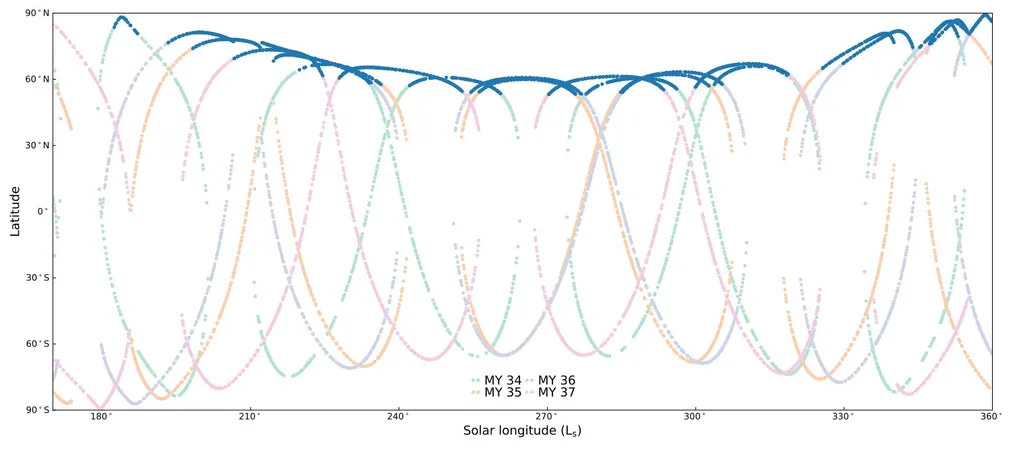
Mars's Chilling Polar Vortex Could Unveil Secrets of Ozone Formation
2025-09-17
Author: Mei
Unveiling Mars's Frigid North Polar Vortex
Scientists have uncovered extraordinary details about the Martian north polar vortex, revealing that its temperatures plunge significantly lower than those of the surrounding atmosphere. According to Dr. Kevin Olsen from the University of Oxford, temperatures in this icy whirlpool can be a staggering 40°C colder than the conditions outside.
Ozone Surges in Wintry Darkness
The perpetual darkness that envelops Mars's north pole during winter plays a crucial role in boosting ozone levels in the atmosphere. Typically, ozone is broken down by molecules released when ultraviolet sunlight breaks apart water vapor. However, during this frigid time, with water vapor frozen out and deposited atop the ice cap, ozone can accumulate rather than being destroyed. As Dr. Olsen points out, "Ozone is vital for understanding the atmospheric chemistry of Mars and could provide clues about the planet's past, including the potential existence of a protective ozone layer like that on Earth."
The Importance of Ozone on Mars
Understanding ozone is paramount; it's a highly reactive form of oxygen that indicates how active chemical processes are in Mars's atmosphere. Dr. Olsen emphasizes that by analyzing ozone levels, researchers can gain valuable insights into the planet's atmospheric evolution and whether it could have once supported life—a tantalizing prospect for the upcoming ExoMars Rosalind Franklin rover set to launch in 2028.
How Mars's Polar Vortex Forms
Mars's seasons are born from a tilt of 25.2 degrees on its axis. Similar to Earth, the changing seasons create atmospheric vortices, which persist from late summer into early spring at the Martian north pole. In some cases, this polar vortex can destabilize, offering a rare chance to delve into its mysteries.
Peering into the Vortex's Secrets
Olsen utilizes the European Space Agency’s ExoMars Trace Gas Orbiter, specifically its Atmospheric Chemistry Suite (ACS), to study the Martian atmosphere. By observing the planet’s limb when the sun is positioned behind it, the ACS identifies atmospheric molecules based on the sunlight's absorption at various wavelengths. However, during the long Martian winter, total darkness makes these observations challenging.
To address this, Olsen collaborated with NASA's Mars Reconnaissance Orbiter, employing its Mars Climate Sounder to assess vortex temperatures. "A sudden drop in temperature indicates an entrance into the vortex," he notes. This collaboration reveals stark differences between the atmospheric conditions inside and outside the polar vortex.
Unlocking Mars’s Atmospheric Mysteries
As researchers probe the polar vortex, they stand on the brink of significant discoveries about Martian atmospheric chemistry. Understanding how ozone builds up during the polar night might just unlock the secrets of Mars's climatic history and its ability—or inability—to nurture life.


 Brasil (PT)
Brasil (PT)
 Canada (EN)
Canada (EN)
 Chile (ES)
Chile (ES)
 Česko (CS)
Česko (CS)
 대한민국 (KO)
대한민국 (KO)
 España (ES)
España (ES)
 France (FR)
France (FR)
 Hong Kong (EN)
Hong Kong (EN)
 Italia (IT)
Italia (IT)
 日本 (JA)
日本 (JA)
 Magyarország (HU)
Magyarország (HU)
 Norge (NO)
Norge (NO)
 Polska (PL)
Polska (PL)
 Schweiz (DE)
Schweiz (DE)
 Singapore (EN)
Singapore (EN)
 Sverige (SV)
Sverige (SV)
 Suomi (FI)
Suomi (FI)
 Türkiye (TR)
Türkiye (TR)
 الإمارات العربية المتحدة (AR)
الإمارات العربية المتحدة (AR)